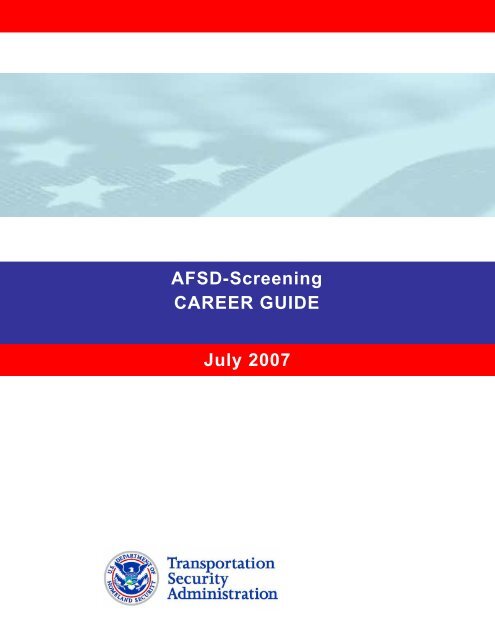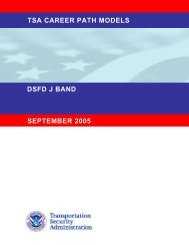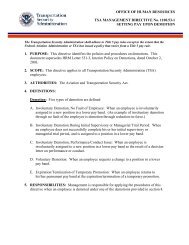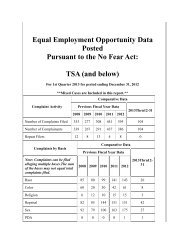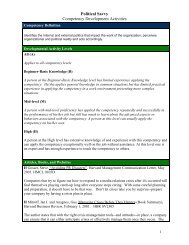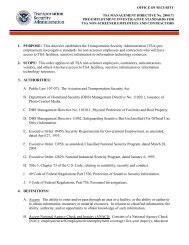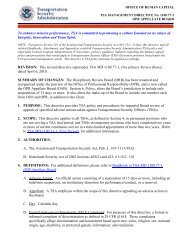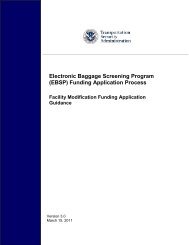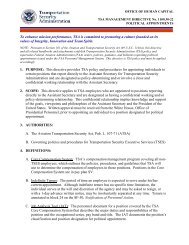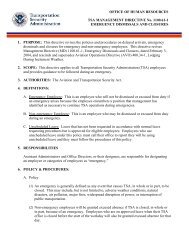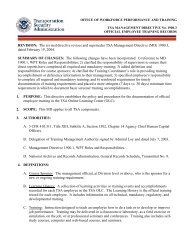(AFSD) for Screening - Transportation Security Administration
(AFSD) for Screening - Transportation Security Administration
(AFSD) for Screening - Transportation Security Administration
You also want an ePaper? Increase the reach of your titles
YUMPU automatically turns print PDFs into web optimized ePapers that Google loves.
<strong>AFSD</strong>-<strong>Screening</strong><br />
CAREER GUIDE<br />
July 2007
Table of Contents<br />
Summary Profile <strong>AFSD</strong>-<strong>Screening</strong> .........................................................................................................2<br />
Major Responsibilities and Activities ......................................................................................................3<br />
Broad-based Development Assignments and Activities .........................................................................6<br />
Critical Competencies and Behaviors .....................................................................................................7
Summary Profile – <strong>AFSD</strong>-<strong>Screening</strong><br />
Major Responsibilities<br />
1. Setting Overall Direction <strong>for</strong> <strong>Screening</strong> Operations<br />
2. Managing <strong>Screening</strong> Operations<br />
3. Implementing TSA Policies and Procedures<br />
4. Handling Personnel Issues <strong>for</strong> Overall <strong>Screening</strong> Work<strong>for</strong>ce<br />
5. Coaching and Developing Direct Reports<br />
6. Coordinating and Collaborating Across Functions<br />
7. Managing External Relationships<br />
8. Selecting and Promoting <strong>Screening</strong> Personnel<br />
9. Responding to Critical Incidents<br />
10. Making Recommendations <strong>for</strong> TSA Policies and Regulations<br />
Critical General Competencies<br />
1. Accountability<br />
2. <strong>Administration</strong> and Management<br />
3. Customer Service<br />
4. Decisiveness<br />
5. Flexibility<br />
6. Human Resource Management<br />
7. Integrity/Honesty<br />
8. Interpersonal Skills<br />
9. Listening<br />
10. Oral Communication<br />
11. Planning and Evaluating<br />
12. Problem Solving<br />
13. Self Management<br />
14. Team Building<br />
15. Written Communication<br />
Critical Technical Competencies<br />
1. Operations Management<br />
2. Safety Policies and Procedures<br />
3. <strong>Security</strong> Directives and Regulations<br />
4. <strong>Security</strong> <strong>Screening</strong> Policies and Procedures<br />
2
Major Responsibilities <strong>AFSD</strong>-<strong>Screening</strong><br />
Major Responsibilities – <strong>AFSD</strong>-<strong>Screening</strong><br />
Responsibility activities appear in order descending from most important to least important<br />
1. Setting Overall Direction <strong>for</strong> <strong>Screening</strong> Operations<br />
a) Clarifying and communicating expectations <strong>for</strong> screening operations, including but not limited to<br />
attendance, appearance, fitness <strong>for</strong> duty, workers comp issues and employees on light duty<br />
b) Participating in screening operations meetings and briefings to present new in<strong>for</strong>mation, provide<br />
"big picture" rationale and visible support <strong>for</strong> changes<br />
c) Communicating and managing operations per<strong>for</strong>mance standards (e.g., wait-times, overtime,<br />
customer service, etc.) <strong>for</strong> the airport<br />
2. Managing <strong>Screening</strong> Operations<br />
a) In<strong>for</strong>ming FSD of key issues and status of screening operations (e.g., personnel, safety hazards,<br />
equipment, etc.) as appropriate<br />
b) Monitoring screening operations through daily reports from <strong>Security</strong> Managers and/or Operations<br />
Centers and/or observing passenger and baggage checkpoints<br />
c) Providing direct, concrete feedback to appropriate managerial/supervisory personnel regarding<br />
local successes and failures<br />
d) Providing overall direction to SOO, <strong>Security</strong> Managers, STSOs and Lead TSOs<br />
e) Visiting checkpoints to stay in touch with TSOs and their interests, issues and concerns<br />
f) Conducting periodic staff meetings, as necessary, with <strong>Security</strong> Managers<br />
g) Establishing communication process to elicit ideas from screening personnel to improve<br />
screening processes and procedures<br />
h) Managing distribution of workloads across <strong>Security</strong> Managers and STSOs<br />
i) Managing allocated resources to meet screening operations objectives and per<strong>for</strong>mance<br />
standards Communicating and managing operations per<strong>for</strong>mance standards (e.g., wait-times,<br />
overtime, customer service, etc.) <strong>for</strong> the airport<br />
3. Implementing TSA Policies and Procedures<br />
a) Ensuring effective local implementation of TSA directives<br />
b) Ensuring appropriate monitoring of screening operations to verify that changes have been<br />
correctly implemented<br />
c) Developing airport-specific procedures when gaps are identified or local circumstances require it<br />
d) Communicating in<strong>for</strong>mation and changes from TSA Headquarters to screening personnel (e.g.,<br />
changes in organizational or screening/security policies and procedures)<br />
3
Major Responsibilities <strong>AFSD</strong>-<strong>Screening</strong><br />
4. Handling Personnel Issues <strong>for</strong> Overall <strong>Screening</strong> Work<strong>for</strong>ce<br />
a) Conducting mid-year and annual per<strong>for</strong>mance evaluations with screening management personnel<br />
b) Facilitating the resolution of HR related issues (e.g., sexual harassment, EEO/discrimination)<br />
c) Keeping screening personnel motivated during long work hours, high pressure work periods, and<br />
periods of organizational change<br />
d) Overseeing and/or reviewing disciplinary actions to ensure that proper procedures are followed<br />
e) Ensuring that TSO questions and issues concerning HR policies and regulations are answered or<br />
addressed through chain of command<br />
f) Encouraging that misunderstandings and conflicts among personnel be resolved through chain of<br />
command<br />
5. Coaching and Developing Direct Reports<br />
a) Ensuring that training goals and standards are being met<br />
b) Delegating tasks to direct reports to develop their skill sets and broaden their experience<br />
c) Meeting regularly with direct reports to discuss career and development goals and opportunities<br />
d) Establishing collaborative working relationships with direct reports<br />
e) Ensuring effective on-the-job training and coaching of TSOs is conducted by the SMs and STSOs<br />
6. Coordinating and Collaborating Across Functions<br />
a) Functioning as acting FSD when necessary<br />
b) Ensuring that cross-functional problem-solving is done at the appropriate level<br />
c) Establishing collaborative working relationships with other <strong>AFSD</strong>s, Training Coordinator(s),<br />
Scheduling Operations Officer and Administrative Officer<br />
7. Managing External Relationships<br />
a) Establishing working relationships with stakeholders to encourage open communication<br />
b) Visiting spoke airports periodically to meet with key stakeholders (e.g., airport director, airline<br />
managers)<br />
c) Along with TSA Stakeholder Manager, coordinating operations with airport, airline operators and<br />
indirect air carrier representatives, local law en<strong>for</strong>cement, contract security and other<br />
stakeholders<br />
d) Working with air carriers to ensure efficient passenger flow processes while maintaining security<br />
standards<br />
e) Coordinating facility planning with external stakeholders when it impacts the screening<br />
organization (e.g., screening operations layout)<br />
f) Along with TSA Stakeholder Manager, acting as a contact point <strong>for</strong> some stakeholders (e.g.,<br />
airline reps, airport director)<br />
4
Major Responsibilities <strong>AFSD</strong>-<strong>Screening</strong><br />
8. Selecting and Promoting <strong>Screening</strong> Personnel<br />
a) Developing, planning and implementing internal promotion processes <strong>for</strong> screening personnel<br />
b) Collaborating with HR to provide resources to process <strong>for</strong> selecting screening personnel (e.g.,<br />
recruiting, interviewing)<br />
9. Responding to Critical Incidents<br />
c) Ensuring that the chain of command is followed when crises or difficult situations arise<br />
d) Providing direction to <strong>Security</strong> Managers <strong>for</strong> serious, escalated screening incidents/crises and<br />
ensuring proper communication as directed by FSD<br />
e) Serving as a point of contact <strong>for</strong> the air operators in a crisis or security risk situation, as directed<br />
or required by FSD<br />
10. Making Recommendations <strong>for</strong> TSA Policies and Regulations<br />
f) Drafting policies to handle un<strong>for</strong>eseen security risks (e.g., previously unidentified hazardous<br />
materials) and filling policy gaps<br />
g) Reviewing draft policy from TSA headquarters and providing input<br />
h) Serving on local airport committees or task <strong>for</strong>ces (e.g., Airport Planning Committee) when<br />
needed<br />
i) Serving on TSA organizational committees or task <strong>for</strong>ces (e.g., Screener Advocacy Board) when<br />
needed<br />
5
Broad-based Development Assignments <strong>AFSD</strong>-<strong>Screening</strong><br />
Broad-based Development Assignments – <strong>AFSD</strong>-<strong>Screening</strong><br />
Activities appear in order descending from most frequently cited as valuable to least frequently<br />
cited as valuable<br />
1. TSA Field Assignments<br />
a) <strong>Security</strong> Manager<br />
b) Deputy <strong>AFSD</strong>-<strong>Screening</strong><br />
c) Details to larger airports, if working at smaller airport<br />
d) Scheduling Operations Officer<br />
e) Stakeholder Manager<br />
f) Supervisory TSO<br />
g) Customer Service Manager<br />
h) Training Coordinator<br />
i) Special projects to address specific issues of importance to airport or TSA overall<br />
j) ER Specialist<br />
k) TSI<br />
l) TSOC Assignment<br />
m) HQ Assignment<br />
n) Shadowing a TSI<br />
o) Working with local Air Carrier to understand their operations and how they are impacted by<br />
screening<br />
2. Training, Conferences, Meetings<br />
a) Management or supervisory training (e.g., USDA Leadership courses, Skill Path, Covey courses)<br />
b) Training to develop oral/written communication skills and interpersonal skills<br />
c) Training in conflict management<br />
d) Training in handling problem employees and creating and implementing per<strong>for</strong>mance<br />
improvement plans (PIP)<br />
e) Outside education (e.g., management degree, HR degree)<br />
f) TSA's Mid-Level Development Program (MLDP)<br />
g) ER Bootcamp<br />
3. On-the-Job Development Activities<br />
a) Serving as Acting <strong>AFSD</strong>-<strong>Screening</strong> (good <strong>for</strong> <strong>Security</strong> Managers)<br />
b) Shadowing <strong>AFSD</strong>-<strong>Screening</strong> at other airports<br />
c) Working through <strong>Screening</strong> Allocation Model with someone who understands it in order to<br />
determine screening FTE levels<br />
d) Being mentored by <strong>AFSD</strong>-<strong>Screening</strong><br />
e) Shadowing <strong>AFSD</strong>-<strong>Screening</strong> at own airport<br />
f) Completing a <strong>Screening</strong> Schedule Bid with Scheduling Operations Officer<br />
g) Shadowing <strong>AFSD</strong>-Inspection to learn what they do and the regulations they en<strong>for</strong>ce<br />
h) Shadowing someone from Airport Operator to learn about local airport operations<br />
6
Competencies and Behaviors <strong>AFSD</strong>-<strong>Screening</strong><br />
Competencies and Behaviors – <strong>AFSD</strong>-<strong>Screening</strong><br />
Behaviors appear in order descending from most important to least important<br />
Critical General Competencies<br />
Accountability<br />
a) Takes ownership <strong>for</strong> resolving problems rather than allowing them to persist or simply pointing them out to others<br />
b) Holds managers and supervisors accountable <strong>for</strong> leading effectively<br />
c) Publicly supports and takes personal responsibility <strong>for</strong> implementing new TSA directives and screening operations<br />
changes<br />
d) Sets challenging per<strong>for</strong>mance goals and holds self and others accountable <strong>for</strong> achieving them<br />
e) Communicates clear per<strong>for</strong>mance expectations and consequences <strong>for</strong> failing to achieve them<br />
f) Establishes per<strong>for</strong>mance metrics that focus employees on accomplishing priority goals and objectives<br />
<strong>Administration</strong> and Management<br />
a) Ensures that all functional managers are following consistent procedures and <strong>for</strong>mats <strong>for</strong> monitoring and documenting<br />
actions and results in their functions<br />
b) Sets up systems <strong>for</strong> tracking activities and results in major administrative and operational functions<br />
c) Allocates administrative and equipment resources to accomplish annual management plan and priorities<br />
Customer Service<br />
a) Ensures that passenger and stakeholder concerns are responded to in a prompt and courteous manner while remaining<br />
firm about security procedures<br />
b) Actively involves airline personnel in collaborative development of solutions that maximize efficiency and customer<br />
service without sacrificing security<br />
c) Responds quickly to questions and in<strong>for</strong>mation requests from internal and external sources<br />
d) Asks stakeholders <strong>for</strong> feedback to identify areas <strong>for</strong> improvement in screening operations<br />
e) Develops appropriate process improvement plans in response to passenger and stakeholder needs<br />
7
Competencies and Behaviors <strong>AFSD</strong>-<strong>Screening</strong><br />
Decisiveness<br />
a) Responds calmly and acts decisively when dealing with crises and security incidents<br />
b) Exhibits courage to make tough administrative, personnel and/or other decisions even when they are unpopular<br />
c) Persists to overcome obstacles and resistance in an ef<strong>for</strong>t to achieve important goals and results (e.g., reduction of<br />
injuries)<br />
d) Exhibits willingness to accept responsibility <strong>for</strong> the consequences of own decisions<br />
e) Expresses confidence in own judgment and decisions when dealing with difficult and/or ambiguous situations<br />
f) Identifies corrective actions that can be implemented immediately in response to a security incident or identified security<br />
risk<br />
g) Makes timely decisions in situations that require it<br />
Flexibility<br />
a) Quickly adapts to changing circumstances, regulations, directives, policies or procedures<br />
b) Responds quickly, calmly, and appropriately on a 24/7 basis to handle significant incidents and crises<br />
c) Responds quickly and calmly to crises and security threats redirects resources as needed to address and resolve them<br />
d) Quickly recognizes changing circumstances and threats<br />
Human Resource Management<br />
a) Ensures that employee issues and complaints are constructively resolved at lowest possible level<br />
b) Ensures accurate estimates of full-time and part-time employees needed to provide adequate coverage of baggage and<br />
passenger screening requirements during peak and non-peak periods<br />
c) Establishes plans and processes <strong>for</strong> developing employees <strong>for</strong> higher level positions within local TSA operation<br />
d) Holds senior staff accountable <strong>for</strong> training and mentoring less experienced staff<br />
e) Coaches and counsels managers and supervisors on how to lead their people effectively and how to deal constructively<br />
with personnel issues<br />
f) Develops and promotes supervisory staff from within TSA whenever possible<br />
8
Competencies and Behaviors <strong>AFSD</strong>-<strong>Screening</strong><br />
Integrity/Honesty<br />
a) Admits own mistakes and take action to address/resolve them<br />
b) Demonstrates the courage to do the right thing in difficult situations<br />
c) Gives people honest and fair answers to difficult questions<br />
d) Holds self and others accountable <strong>for</strong> meeting high standards of integrity<br />
e) Leads by example through modeling desired practices and standards in own behavior<br />
f) Delivers on commitments made to others<br />
g) Avoids any action or situation that would give the appearance of unethical or inappropriate behavior<br />
Interpersonal Skills<br />
a) Expresses interest in and an ability to relate effectively to all levels of TSA employees and stakeholders<br />
b) Spends time with front-line employees to get to know them and build rapport and trust<br />
c) Listens attentively to employee ideas, issues and concerns and takes steps to address them<br />
d) Makes self accessible and approachable to employees; utilizes open door policy<br />
Listening<br />
a) Listens carefully to the issues and concerns of employees and stakeholders and communicates understanding of them<br />
b) Pays attention to and interprets non-verbal messages and cues (such as body language and tone of voice) in order to<br />
understand reactions and concerns of people in security incidents and other situations<br />
c) Responds to others in ways that make them feel understood<br />
d) Asks questions to clarify statements made by others, including their underlying concerns and issues<br />
9
Competencies and Behaviors <strong>AFSD</strong>-<strong>Screening</strong><br />
Oral Communication<br />
a) Communicates in<strong>for</strong>mation concisely and clearly<br />
b) Delivers difficult or sensitive in<strong>for</strong>mation openly, honestly and with empathy<br />
c) Explains complex concepts (e.g., schedules, policies or procedures) clearly and at an appropriate level of detail<br />
d) Adjusts communication style and language to most effectively connect with different/diverse audiences and individuals<br />
e) Maintains frequent appropriate level of contact with TSA senior management to keep them in<strong>for</strong>med about important or<br />
controversial cases and situations<br />
f) Exhibits awareness of the impact of own words, actions or decisions on others<br />
g) Asks questions to understand the ideas, issues and concerns of others, and their root causes<br />
Planning and Evaluating<br />
a) Continually re-examines priorities and plans and makes changes as needed to reflect changing realities<br />
b) Sets and adjusts local/own priorities to reflect national programs and priorities while responding to local needs and<br />
circumstances<br />
c) Determines clear objectives and strategies <strong>for</strong> addressing key issues of screening operations<br />
d) Organizes work, sets priorities, and determines resource requirements in conjunction with other managers<br />
e) Coordinates with other parts of the local TSA organization to accomplish goals<br />
f) Sets up systems <strong>for</strong> monitoring and tracking progress against the annual goals and plans<br />
g) Develops <strong>for</strong>ms <strong>for</strong> documenting specific issues, problems, actions and results <strong>for</strong> program/process improvement ef<strong>for</strong>ts<br />
10
Competencies and Behaviors <strong>AFSD</strong>-<strong>Screening</strong><br />
Problem Solving<br />
a) Involves employees, airlines and other stakeholders in process of identifying and solving problems that impact them<br />
b) Exhibits a "can-do" attitude in response to challenging directives, problems and situations<br />
c) Asks probing questions to clarify situations and identify root causes of security and/or personnel problems<br />
d) Suspends judgment and maintains objectivity in situations until essential facts are gathered and analyzed<br />
e) Recognizes patterns and trends in data<br />
f) Surveys TSA front-line employees to identify problems that need to be solved or processes that need to be improved<br />
g) Considers the big picture when dealing with new or complex situations, rather than rigidly applying policies, directives<br />
and regulations or procedures<br />
h) Listens to front-line employees to learn what is being done and how it's being done<br />
i) Looks at problems systemically and develops systemic solutions<br />
j) Analyzes costs and benefits of potential solutions when addressing operational issues and problems<br />
k) Escalates issues with contractor management, when necessary, in order to overcome obstacles and expedite responses<br />
to urgent TSA needs and situations<br />
l) Assigns ownership <strong>for</strong> solving problems to TSA individuals and teams<br />
Self Management<br />
a) Sets well-defined and realistic goals <strong>for</strong> accomplishing planned programs and initiatives while responding to daily<br />
demands and security incidents as they occur<br />
b) Takes initiative to identify issues/needs and develop programs or processes that improve TSA's<br />
administrative/operational efficiency and effectiveness<br />
c) Maintains professional behavior when dealing with difficult people or high stress situations<br />
11
Competencies and Behaviors <strong>AFSD</strong>-<strong>Screening</strong><br />
Team Building<br />
a) Delegates authority and responsibility to direct staff and empowers them to make decisions and take action within their<br />
areas of accountability<br />
b) Recognizes and rewards individuals and teams <strong>for</strong> outstanding per<strong>for</strong>mance and/or achieving significant goals<br />
c) Coaches and mentors direct staff to maximize their current effectiveness and/or prepare them <strong>for</strong> higher level<br />
responsibilities<br />
d) Provides employees with the tools, in<strong>for</strong>mation and support they need to take action and make decisions<br />
e) Personally spends time at checkpoints during Holidays to show support <strong>for</strong> TSA employees (e.g., moving bins and bags)<br />
f) Directly addresses problematic behavior in others while focusing on turning the behavior around<br />
g) Gives positive feedback to employees <strong>for</strong> doing good work and achieving results<br />
h) Provides direct, observation-based, constructive per<strong>for</strong>mance feedback on an on-going basis<br />
i) Stands up <strong>for</strong> TSA employees when airline employees or other stakeholders treat them unprofessionally or<br />
inappropriately<br />
j) Stretches people's capabilities and per<strong>for</strong>mance by giving them challenging tasks/assignments<br />
k) Elicits employee suggestions, implements them and recognizes employees <strong>for</strong> contributing them<br />
l) Builds overall morale by directly addressing underachieving employees and getting them to contribute their skills and<br />
add value<br />
m) Asks questions to help others think through their own solutions to problems or situations<br />
n) Accurately assesses what employees are capable of handling and gives them challenging assignments and<br />
responsibilities that stretch those capabilities<br />
o) Gives staff room to learn from making mistakes that are not too big<br />
p) Organizes and challenges teams to address specific operational or administrative issues and problems<br />
Written Communication<br />
a) Expresses facts and ideas in writing in a clear, convincing and organized manner that is appropriate to the audience and<br />
occasion<br />
b) Uses a variety of written communications to communicate and rein<strong>for</strong>ce TSA's mission and accomplishments to<br />
employees and stakeholders (e.g., e-mails, newsletters, presentations,)<br />
c) Writes clear and concise inspection and investigation reports that capture important in<strong>for</strong>mation without unnecessary<br />
detail<br />
d) Writes quickly and clearly in order to complete the reports and communications that are associated with the job<br />
12
Competencies and Behaviors <strong>AFSD</strong>-<strong>Screening</strong><br />
Critical Technical Competencies<br />
Operations Management<br />
a) Continuously improves local screening operations processes<br />
b) Builds processes to efficiently accomplish TSA screening responsibilities<br />
c) Demonstrates an understanding of the big picture of TSA operations<br />
Safety Policies and Procedures<br />
a) Identifies safety issues and risks and takes steps to address them<br />
b) Understands essential safety policies and procedures and ensures that employees are well trained to comply with them<br />
<strong>Security</strong> Directives and Regulations<br />
a) Knows where to find in<strong>for</strong>mation on security directives and regulations and leverages inspectors who know them in detail<br />
b) Demonstrates overall understanding/awareness of TSA security policies, directives and regulations (e.g., HazMat<br />
regulations, airport vs. air carrier directives, confidentiality and security SOPs, identification of prohibited items, current<br />
threats to airport<br />
c) Recognizes discrepancies in implementation of security directives and regulations by airport and/or air carriers and<br />
knows when en<strong>for</strong>cement investigations should be initiated<br />
<strong>Security</strong> <strong>Screening</strong> Policies and Procedures<br />
a) Demonstrates thorough understanding of screening policies and procedures<br />
b) Knows how to find Standard Operating Procedures in<strong>for</strong>mation and leverages other people who know it<br />
13


